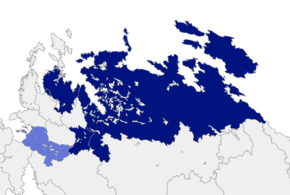Telmerian Union
This article is incomplete because it is pending further input from participants, or it is a work-in-progress by one author. Please comment on this article's talk page to share your input, comments and questions. Note: To contribute to this article, you may need to seek help from the author(s) of this page. |
Telmerian Union
| |||
|---|---|---|---|
|
Flag | |||
| Motto: "Stärke in Einheit" (Hesurian) "Strength in Unity" | |||
| Anthem: "Sarabande" (instrumental) | |||
 Telmerian Union members (blue) and associated partners (light blue) | |||
| Capital | Lilienburg City (de facto) | ||
| Largest city | Flussmund | ||
| Other languages | Hesurian, Valimian, Valtrivan | ||
| Type | Political and economic union | ||
| Membership | 5 states | ||
| Leaders | |||
• General Secretary | Matthias Gaissler | ||
• President of the Council | Sigita Kulėšienė | ||
• President of the Parliamentary Assembly | Werther Sahlen | ||
| Establishment | |||
• Treaty of Lilienburg | 21 March 1984 | ||
• Treaty of Eichau | 6 November 1990 | ||
• Treaty of Aketerina | 13 September 1994 | ||
| Area | |||
• Total | 1,812,066 km2 (699,643 sq mi) | ||
• Water (%) | 1.9% | ||
| Population | |||
• 2019 estimate | |||
| GDP (nominal) | 2019 estimate | ||
• Total | |||
• Per capita | $32,877 | ||
| Gini (2019) | 36.5 medium | ||
| HDI | 0.885 very high | ||
The Telmerian Union (TU) is an economic union and regional organization consisting of five states of Telmeria, primarly aimed at economic integration and increased interggovernmental collaboration among them. The TU has strived to increase the free movement of goods, services and people between the nations of Telmeria, enact internationally binding decisions on maintaining common policies, and many ideas surrounding more Telmerian unionism and integration have emerged due to the TU's success of unifying its member states, particularly following the conclusion of the Great Game. The union is headed by the High Secretariat and a respective General Secretary, the Council of the Telmerian Union and the Telmerian Parliamentary Assembly; all institutions are headquartered in Lilienburg City. The TU was formally founded in the Treaty of Lilienburg, signed into effect on 21 March 1984 between Mascylla, Lilienburg and Temaria as the Inner Three of the union; it witnessed membership growth by the accession of two more member states, namely Valimia in 1990 and Valtriva in 1991.
As a supranational organization, it has made efforts to synchronise national judiciary into a uniform set of laws that apply to all members. An internal customs union (Telmerian Joint Customs Union, TJCU) was developed in 1990, coming into effect in 1992, and has abolished passport control for travel within the TU in favour of TU citizenship. It also achieved a single market (Telmerian Single Market, TSM) in 1994. These agreements also partially extended to and integrated with the members of the Berean Economic Community (BEC), establishing the Common Berean Economic Area (CBEA) of nine states in 2000. One of the largest movements of further integration is the establishment of a common currency and monetary union between the member states, which is currently debated.
The union is often described and credited as a potential superpower, mainly through the emergence of the Shared Security Architecture Policy with the 1994 Treaty of Aketerina to constitutionalize and formulate its role in international law and the geopolitical system outlined by the Assembly of Nations, its external relations, and defence. Its member states comprise 223.7 million inhabitants, or 18.5 percent of the world population, and generated a nominal gross domestic product (GDP) of US$ 7.016 trillion in 2020, or 22.2 percent of the world's total GDP.

